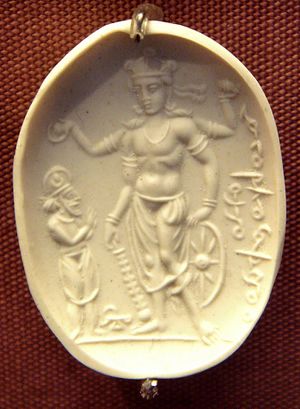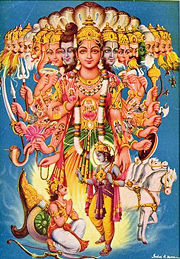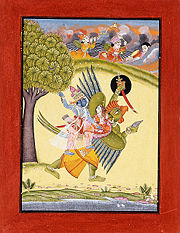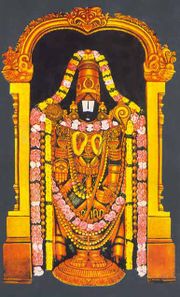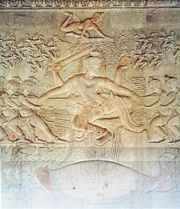ڤشنو
| Vishnu | |
|---|---|
God of Preservation[1]
| |
| عضو في Trimurti[6] | |
 Painting depicting Vishnu, c. 1730 | |
| أسماء أخرى | |
| الانتماء | |
| المسكن | |
| مانترا | |
| السلاح | |
| الرموز | |
| Day | Thursday |
| الجبل | |
| الأعياد | |
| معلومات شخصية | |
| الأشقاء | Durga as Yogamaya (ceremonial sister)[11][12] |
| القرين | Lakshmi and her forms |
| الأنجال | |
الإله ڤِشنو (ديڤنگاري: विष्णु) في العقيدة الهندية هو إله الحبّ ، وهو النشيط الفعال ، وكثيراً ما ينقلب إلى إنسانٍ يُساعد البشر. ومن أكثر الصور التي يتجسد بها إنسانا كما ترى العقيدة الهندية هي صور كرشنا وهو إنسان مظلوم كان مسجونا ثم حرر من السجن وخرج للعالم ليشفى المرضى ويساعد المحتاجين ويجيب المظلومين.
يوصف فيشنو في فيشنو سهاسراناما[13] بأنه الجوهر الحال في كل الكائنات ورب الماضي والحاضر والمستقبل وخالق ومدمر كل الموجودات والإله الذي يدعم ويحفظ ويحكم الكون ويخلق ويطور كل ما فيه.
ويوصف في البورانا بأن له لون السحاب الأزرق الغامق وأربعة أذرع يمسك بها زهرة اللوتس ومشكاة وقوقعة وحلقة.
وفي البورانا وصف لأفاتارات فيشنو، حيث حدثت تسعة من هذه الأفاتارات أو التجسدات في الماضي وبقي تجسد واحد ليحصل. وهدف التجسدات تجديد الدارما[14] والقضاء على القوى الشريرة. وفيشنو يعبد في كل تقاليد ساناتانا دارما بشكل مباشر أو عبر الأفاتارات مثل راما وكريشنا وناراسيمها.
فيشنو في التريمورتي مسؤول عن حفظ العالم بينما الخلق وظيفة براهما والتدمير وظيفة شيفا.
According to Vaishnavism, the supreme being is with qualities (Saguna), and has definite form, but is limitless, transcendent and unchanging absolute Brahman, and the primal Atman (Self) of the universe.[15] There are both benevolent and fearsome depictions of Vishnu. In benevolent aspects, he is depicted as an omniscient being sleeping on the coils of the serpent Shesha (who represents time) floating in the primeval ocean of milk called Kshira Sagara with his consort, Lakshmi.[16]
Whenever the world is threatened with evil, chaos, and destructive forces, Vishnu descends in the form of an avatar (incarnation) to restore the cosmic order and protect dharma. The Dashavatara are the ten primary avatars of Vishnu. Out of these ten, Rama and Krishna are the most important.[17]
التسمية
Vishnu (also spelled Viṣṇu, سنسكريتية: विष्णु) means 'all pervasive'[18] and, according to Medhātith (ح. 1000 CE), 'one who is everything and inside everything'.[19] Vedanga scholar Yaska (4th century BCE) in the Nirukta defines Vishnu as viṣṇur viṣvater vā vyaśnoter vā ('one who enters everywhere'); also adding atha yad viṣito bhavati tad viṣnurbhavati ('that which is free from fetters and bondage is Vishnu').[20]
In the tenth part of the Padma Purana (4-15th century CE), Danta (Son of Bhīma and King of Vidarbha) lists 108 names of Vishnu (17.98–102).[21] These include the ten primary avatars (see Dashavarara, below) and descriptions of the qualities, attributes, or aspects of God.
The Garuda Purana (chapter XV)[22] and the "Anushasana Parva" of the Mahabharata both list over 1000 names for Vishnu, each name describing a quality, attribute, or aspect of God. Known as the Vishnu Sahasranama, Vishnu here is defined as 'the omnipresent'.
Other notable names in this list include :
- Hari
- Lakshmikanta
- Jagannatha
- Janardana
- Govinda
- Hrishikesha
- Padmanabha
- Mukunda
- Narayana
Iconography
Vishnu iconography shows him with dark blue, blue-grey or black coloured skin, and as a well-dressed jewelled man. He is typically shown with four arms, but two-armed representations are also found in Hindu texts on artworks.[23][24]
The historic identifiers of his icon include his image holding a conch shell (shankha named Panchajanya) between the first two fingers of one hand (left back), a war discus (chakra named Sudarshana) in another (right back). The conch shell is spiral and symbolizes all of interconnected spiraling cyclic existence, while the discus symbolizes him as that which restores dharma with war if necessary when cosmic equilibrium is overwhelmed by evil.[23] One of his arms sometimes carries a club or mace (gada named Kaumodaki) which symbolizes authority and power of knowledge.[23] In the fourth arm, he holds a lotus flower (padma) which symbolizes purity and transcendence.[23][24][25] The items he holds in various hands vary, giving rise to twenty four combinations of iconography, each combination representing a special form of Vishnu. Each of these special forms is given a special name in texts such as the Agni Purana and the Padma Purana. These texts, however, are inconsistent.[26] Rarely, Vishnu is depicted bearing the bow Sharanga or the sword Nandaka. He is depicted with the Kaustubha gem in a necklace and wearing Vaijayanti, a garland of forest flowers. The shrivatsa mark is depicted on his chest in the form of a curl of hair. He generally wears yellow garments. He wears a crown called the Kiritamukuta.[27]
Vishnu iconography shows him either in standing pose, seated in a yoga pose, or reclining.[24] A traditional depiction of Vishnu is as Narayana, showing him reclining on the coils of the serpent Shesha floating over the divine ocean Kshira Sagara, accompanied by his consort Lakshmi, as he "dreams the universe into reality."[28] His abode is described as Vaikuntha and his mount (vahana) is the bird king Garuda.[29]
Vishnu was associated with the sun because he used to be "a minor solar deity but rose in importance in the following centuries."[30]
The Trimurti
Particularly in Vaishnavism, the Trimurti (also known as the Hindu Triad or Great Trinity)[31][32] represents the three fundamental forces (guṇas) through which the universe is created, maintained, and destroyed in cyclic succession. Each of these forces is represented by a Hindu deity:[33][34]
- Brahma: presiding deity of Rajas (passion, creation)
- Vishnu: presiding deity of Sattva (goodness, preservation)
- Shiva: presiding deity of Tamas (darkness, destruction)
The trimurti themselves are beyond three gunas and are not affected by it.[35]
In Hindu tradition, the trio is often referred to as Brahma-Vishnu-Mahesh. All have the same meaning of three in one; different forms or manifestations of One person the Supreme Being.[36]
ڤشنو في سمريتي وشروتي
في الڤيدا
في البرهمانا
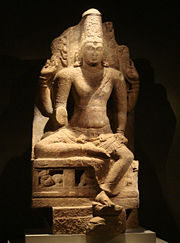
المناقب اللاهوتية
الأقانيم الخمسة
علاقاته مع الآلهة الأخرى
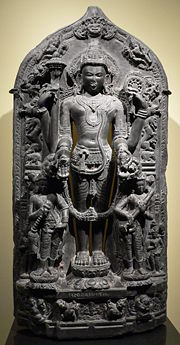
الرموز
There are ten avatars of Vishnu (dashavatara) commonly considered as the most prominent[37]:
- Matsya, السمكة.
- Kurma, السلحفاة.
- Varaha, الخنزير البري.
- ناراسيمها، الرجل-الأسد (نارا = رجل، سيمها = الأسد).
- Vamana, the Dwarf Brahmana (priest).
- Parashurama, Rama with the axe, who appeared in the Treta Yuga.
- Rama, Sri Ramachandra, the prince and king of Ayodhya.
- Krishna (meaning 'dark coloured' or 'all attractive') appeared in the Dwapara Yuga along with his brother Balarama. Balarama is included as the eighth or ninth Dasavatara in some versions of the list which either contain no reference to Buddha, or list Krishna as the source of all avatars.[38]
- Buddha (meaning 'the enlightened one') appeared in the Kali Yuga (specifically as Siddhartha Gautama).
- Kalki ("Eternity", or "time", or "The Destroyer of foulness"), who is expected to appear at the end of Kali Yuga, the time period in which we currently exist.
ألف اسم لڤشنو
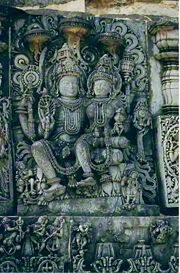
الأسماء مشتقة عموماً من أنانتاكالياناگونا (التي تعني: الصفات الجليلة اللانهائية). بعض الأسماء هي:
- Acyutah (infallible)
- Ananta (endless, eternal, infinite)
- Damodara (having a rope (dama) around his belly (udara): a name of Krishna)
- Govinda (protector of the cows & brahmins; master of the senses: a name of Krishna)
- Hari (one who takes away)
- Hayagriva (giver of knowledge)
- Jagannatha (Owner/Ruler of the world/universe)
- Janardana (One who is worshiped by people for Wealth)
- Kesava (slayer of Keshi, having long or much or handsome hair, from Atharvaveda viii , 6 , 23)
- كرشنا (born during the third epoch or yuga, his deeds range from cow protection (go rakshya) to absolving the earth of load of sins)
- Madhava (relating to the season of spring)
- Madhusudana (he who destroyed the demon called Madhu)
- نارايانا (said to mean "he who is the abode of nār (= ether)", i.e., the whole world's shelter. There are two more meanings of Narayana found in a stuti of child-Krishna by Brahma).
- Padmanabha (lotus-naveled one, from whose navel sprang the lotus which contained Brahma, who created the universe)
- Perumal الاسم الذي يُعرف به في المناطق الناطقة بالتاميلية
- Purushottama - The Supereme Eternal Being
- راما (المولود أثناء الحقبة الثانية من يوگا, his deeds primarily established the ideal living principles of a man)
- Hrsikesha (lord of the senses)
- ساتيانارايانا (a combination of satya and Narayana meaning 'protector of truth')
- Sridhara (consort of Sri = Laxmi or Ultimate wealth)
- Siddhartha (one who attains perfection, birth name of Buddha avatar in the last epoch of Kali Yuga)
- Vishnu
- سريمان (زوجة شري أو لكشمي); Often Sriman is combined with the name, Narayana , to تشكل كلمة مركبة، Sriman Narayana.
- Srinivasa (the abode of Shri) (also specifically referring to his form in the temple at Tirupati). Also the form of Vishnu at Tirupati is well-known as Venkateswara.
- Vamana (dwarfish, small or short in stature, a dwarf brahmana)
- Vāsudeva ( "All-Pervading God", with the long vowel A;it means "the son of Vasudeva": a name of Krishna)
هوامش
- ^ Encyclopedia of World Religions. Encyclopaedia Britannica, Inc. 2008. pp. 445–448. ISBN 978-1-59339-491-2.
- ^ Wendy Doniger (1999). Merriam-Webster's Encyclopedia of World Religions. Merriam-Webster. p. 1134. ISBN 978-0-87779-044-0.
- ^ Soifer 1991, p. 85.
- ^ Doniger, Wendy; O'Flaherty, Wendy Doniger (1 January 1980). Karma and Rebirth in Classical Indian Traditions. University of California Press. Retrieved 26 January 2019 – via Internet Archive.
- ^ Indian Civilization and Culture. M.D. Publications Pvt. 1998. ISBN 9788175330832. Archived from the original on 26 March 2023. Retrieved 20 March 2023.
- ^ For the Trimurti system having Brahma as the creator, Vishnu as the maintainer or preserver, and Shiva as the destroyer. see Zimmer (1972) p. 124.
- ^ أ ب Constance Jones; James D. Ryan (2006). Encyclopedia of Hinduism. Infobase Publishing. pp. 491–492. ISBN 978-0-8160-7564-5. Archived from the original on 20 October 2022. Retrieved 22 May 2017.
- ^ "Shesha, Sesa, Śeṣa, Śeṣā: 34 definitions". 23 August 2009. Archived from the original on 3 August 2022. Retrieved 3 August 2022.
- ^ Muriel Marion Underhill (1991). The Hindu Religious Year. Asian Educational Services. pp. 75–91. ISBN 978-81-206-0523-7.
- ^ Debroy, Bibek (2005). The History of Puranas (in الإنجليزية). Bharatiya Kala Prakashan. ISBN 978-81-8090-062-4.
- ^ Williams, George M. (2008-03-27). Handbook of Hindu Mythology (in الإنجليزية). OUP USA. ISBN 978-0-19-533261-2.
- ^ "Śb 10.4.12". vedabase.io/en/ (in الإنجليزية). Retrieved 24 February 2020.
- ^ http://www.swami-krishnananda.org/vishnu/vishnu_1.html
- ^ Bhagavad Gita 4.7 "...في ذلك الوقت أنزل بنفسي"
- ^ Edwin Bryant; Maria Ekstrand (23 June 2004). The Hare Krishna Movement: The Postcharismatic Fate of a Religious Transplant. Columbia University Press. p. 16. ISBN 978-0231508438. Archived from the original on 22 April 2023. Retrieved 4 November 2020.
- ^ Vanamali (20 March 2018). In the Lost City of Sri Krishna: The Story of Ancient Dwaraka. Simon and Schuster. p. 737. ISBN 978-1620556825.
- ^ Zimmer, Heinrich Robert (1972). Myths and Symbols in Indian Art and Civilization. Princeton University Press. p. 124. ISBN 978-0-691-01778-5.
- ^ Vishnu Sahasranāma, translated by Swami Chinmayananda. Central Chinmaya Mission Trust. pp. 16–17.
- ^ Klaus K. Klostermaier (2000). Hinduism: A Short History. Oneworld. pp. 83–84. ISBN 978-1-85168-213-3.
- ^ Adluri, Vishwa; Joydeep Bagchee (February 2012). "From Poetic Immortality to Salvation: Ruru and Orpheus in Indic and Greek Myth". History of Religions. 51 (3): 245–246. doi:10.1086/662191. JSTOR 10.1086/662191. S2CID 56331632.
- ^ N.A. (1956). THE PADMA-PURANA PART.10. MOTILAL BANARSIDASS PUBLISHERS PVT. DELHI. pp. 3471–3473.
- ^ N.A. (1957). THE GARUDA-PURANA PART. 1. MOTILAL BANARSIDASS PUBLISHERS PVT. DELHI. pp. 44–71.
- ^ أ ب ت ث Steven Kossak; Edith Whitney Watts (2001). The Art of South and Southeast Asia: A Resource for Educators. Metropolitan Museum of Art. pp. 30–31, 16, 25, 40–41, 74–78, 106–108. ISBN 978-0-87099-992-5.
- ^ أ ب ت T. A. Gopinatha Rao (1993). Elements of Hindu iconography. Motilal Banarsidass. pp. 73–115. ISBN 978-81-208-0878-2. Archived from the original on 11 November 2023. Retrieved 4 July 2017.
- ^ James G. Lochtefeld (2002). The Illustrated Encyclopedia of Hinduism. The Rosen Publishing Group. pp. 137, 231 (Vol. 1), 624 (Vol. 2).
• James g. Lochtefeld, PhD (15 December 2001). Vol. 1. Rosen Publishing. ISBN 978-0-8239-3179-8. Archived from the original on 19 January 2023. Retrieved 4 July 2017 – via Google Books.
• Lochtefeld, James G. (2002). Vol. 2. Rosen Publishing. ISBN 978-0-8239-2287-1 – via Internet Archive. - ^ P.B.B. Bidyabinod, Varieties of the Vishnu Image, Memoirs of Archaeological Survey of India, No. 2, Calcutta, pages 23–33
- ^ Blurton, T. Richard (1993). Hindu Art (in الإنجليزية). Harvard University Press. p. 114. ISBN 978-0-674-39189-5. Archived from the original on 26 March 2023. Retrieved 23 February 2023.
- ^ Fred S. Kleiner (2007). Gardner's Art through the Ages: Non-Western Perspectives. Cengage Learning. p. 22. ISBN 978-0495573678.
- ^ "Vishnu | Hindu deity | Britannica". www.britannica.com (in الإنجليزية). 2024-05-31. Retrieved 2024-06-17.
- ^ Stevenson 2000, p. 57.
- ^ See Apte, p. 485, for a definition of Trimurti as 'the unified form' of Brahmā, Viṣṇu and Śiva, as well as the use of phrase "Hindu triad."
- ^ See: Jansen, p. 83, for the term "Great Trinity" in relation to the Trimurti.
- ^ For quotation defining the Trimurti see: Matchett, Freda. 2003. "'The Purāṇas'." In Flood, p. 139.
- ^ For the Trimurti system having Brahma as the creator, Vishnu as the maintainer or preserver, and Shiva as the transformer or destroyer see Zimmer (1972) p. 124.
- ^ "Shiva: The Auspicious One". ISKCON News (in الإنجليزية). 2008-03-06. Archived from the original on 12 February 2022. Retrieved 2022-02-12.
- ^ "Srimad Bhagavatam Canto 1 Chapter 2 Verse 23". Vedabase.net. Archived from the original on 23 November 2010. Retrieved 2011-11-30.
- ^ Garuda Purana Texts 1.86.10-11
- ^ [http://www.salagram.net/Dasavatara-page.htm Dasavatara Page] (salagram.net)
وصلات خارجية
- Vishnu, a description (gurjari.net)
- Vishnu, the form of the quality of goodness (srimadbhagavatam.com)
- Who is Vishnu? Vaishnava FAQ (dvaita.org)
- Thousand names of the Supreme (Vishnu Sahasranama Stotram)
- Hinduism & Vaishnavism (veda.harekrsna.cz)
- List of Vaishnava links (vaishnava.com)
- Devotional hymns for Lord Vishnu (stutimandal.com)
- Satya Narayana Vrat Katha and Vishnu Sahasranama (Devi Mandir)
- Vishnu in Bhavishya Purana as the God in Old Testament
- Short description is different from Wikidata
- Articles having same image on Wikidata and Wikipedia
- Articles containing سنسكريتية-language text
- Articles with hatnote templates targeting a nonexistent page
- Forms of Vishnu
- آلهة هندوسية
- Rigvedic deities
- كلمات وعبارات سنسكريتية
- Solar gods
- Triune gods
- Vaishnavism
- آلهة هندية


